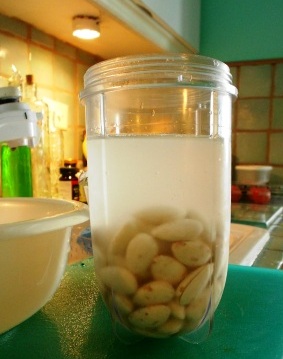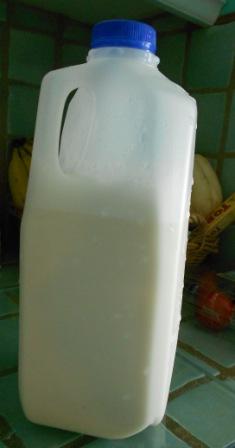Yes… Madelyn, lover all things dairy and cheese, has been put on a dairy-free diet for at least 30 days. 😦
And maybe you’ve found yourself in the same predicament… where most of your go-to recipes have some sort of cheese or dairy component, right?? It’s a way for us vegetarians to get some protein, no???
Nuts, and particular, ALMONDS are a great way to get some protein in you… and you usually think of adding nuts to your diet in a salad or as a garnish for a main dish or a dessert. But what about making milk out of it??? You see alternative dairy products in all major supermarkets now. But have u ever attempted to make it on your own???
It’s easier than you think…
ALMOND MILK FROM SCRATCH
About 1 cup of almonds Water
Yep… that’s all you need. And some tools you already have in your kitchen anyways.
Start by soaking the almonds in some filtered water. I like to soak the almonds for about 1 hour to take off the skin. This is certainly not necessary, but I like my almond milk to be WHITE, just like regular cow’s milk is. After I peel the skins, I re-soak again in more filtered water. This can be from 3-4 hours to overnight. But if you will not do it in 3-4 hours, I recommend placing the soaking almonds in the fridge to prevent fermentation.
Gather all your equipment, just as if you were making a sesame seed horchata – a large pot with a fine sieve, a bowl to collect the ground almonds after they’ve been blended once.
- Place some of the almonds in the large container of your Magic Bullet or blender. Fill almost to the top with filtered water. Here I show you how much water I use.

- Process for a few minutes in 30 second intervals to puree the seeds as much as possible.
- Drain the milky almond pureed water over the sieve. Use a large spoon to move the slush around, but you don’t need to press extremely hard to release all the liquid. If you do, you’ll only push a lot of sediment into the finished “milk”. So there’s no need to use extra muscle for this. Allow gravity and a slight firm hand to do its job.

- Save the leftover almond slush in a bowl for re-processing. Repeat with all the never-processed almonds in the same way as before. I usually divide the original almonds into 3. After processing all the almonds once, reprocess in the exact same way, diving it into batches, but this time after passing it through the sieve, just discard the leftover almond meal.
- Transfer to a bottle where you can serve the almond milk from.
- Chill before serving.
The almond milk will separate when standing in the fridge… but just mix well before serving.
If you want to drink the almond milk by itself… I would add about ½ cup of honey and would strain it again thru the finest sieve you can find. Almond meal is way finer than sesame seeds and there’s much more sediment than when making an horchata. Use a clean fine cotton cloth or even a coffee filter we call “media” to strain as much sediment as possible.
This is an excellent source of calcium and is great to drink by itself, in oatmeals, other hot cereals and smoothies.








The skins don’t actually make the milk brown at all (there’s a bit of sediment that eventually settles at the bottom, but only if you’re not using a really fine sieve). I’d be interested to know if there was a major flavour difference though – I’d probably prefer no skins but I’m too lazy to peel hehe.
i’ll make some more this weekend and report back if i notice any changes in texture or flavor… i am lazy too and don’t make this almond milk as often because of the peeling. If peels do not affect color or taste, you will make my life sooooooooooo much easier!!!!
You make this seem so do-able! I might have to give it a try, making it on your own you could definitely keep preservatives and such out. If you need some dairy free direction head on over to my blog 🙂 it’s not so bad once you get into the swing of it!
thanks michelle!!!! what’s your blog address??? would like to take a look at it!!!!
Left the skins on the one we had on our blog, but it’s probably better to take them off. It’d be great to invest in a nut milk bag to really drain off all the skin and any grainy particles. Oh well. Making nut milk at home is definitely a great way to use up any nuts!
WOW – I would have never thought of making my own almond milk but the technique could not be easier. Can’t wait to give it a try.
At least near me we can get raw almonds that are already peeled. About the same cost also, for those who don’t want to go to the effort if they can find them.
Also, don’t throw out the almond meal after! That can be added to breads very easily, for an extra flavor/protein kick. All kinds, from quick breads (it is great in carrot/banana/zucchini) to regular kneaded types. Wonderful in a multi-grain.
Also can be used in cakes (very good in chocolate) and cookies of all kinds, and even as a faux almond paste, just add a bit of sugar or honey and some almond flavoring. Wonderful as a cookie or cake filling.
Can be used in veggie burgers too, especially ones that are very grain based and take the flavor well. Great in a quinoa/carrot/beet mix I think.
Can even be used in pasta dough, though it does add the almond flavor. (Makes a good ravioli with a sweeter filling, like pumpkin or mascarpone)
Can also be dried, ground down even more and used as almond flour.
Considering how pricey almonds can be, I hate to see the waste!
I enjoy almond milk once in a while, but admit to preferring cashew if I am using a non-dairy “milk” though.
Good to show people how to make their own, what stores charge is just silly!
OMG!!! Sooooo many ideas on what to make with the almond meal. I promise to NEVER, EVER, throw it out again!!!! The other day I learned to use the meal left over of making coconut milk, I guess this is exactly the same thing. I will certainly try making cashew milk… I usually buy cashews roasted and salted, but I will look for the raw to make milk out of. Thanks for the ideas… love it!!!!
It even freezes well if you don’t want to use it right away.
I have some friends who are vegan and make almond milk, but don’t really cook so we have “trades”. I get the almond meal, and then I share whatever things I make from it.
One thing about cashew milk is that there are almost no solids to filter out at all, the cashews almost liquify so you actually get more of the nut in the milk. I love the flavor too.
I do love coconut milk too, and the resulting meal! It is fun to get all you can out of a food, especially those expensive ones. 🙂
I went to Ayurvedic doctor today and he said Almond milk is especially good for women. It has something to do with almond giving moon energy.
Thanks for nice recipe!
Hey everyone! I just wanted to ask about the peels. I removed them today for the first time after seeing your post, added some maple syrup to the milk yum 🙂 But have you found out about the peels yet? It is a little bit more work 😉 And this right here is my favorite pulp leftover recipe : http://www.therawtarian.com/raw-almond-pulp-fudge
According to another commenter, the peels do not affect the color of the milk. you do still need to soak the almonds to make the milk, because the raw almonds are too hard to efficiently make the milk. I peel them.. it’s my preference. You can buy already peeled almonds. They’re available in stores in the US. Maybe a tad more expensive, but it saves you time and effort.
Does this answer your question about the peels? If not, I am glad to answer any other specific questions you may have. Madelyn.
What makes your preference to peel them though? I always soak them, I don’t think I can taste a difference in peeled & unpeeled. Only thing is the pulp looks way nicer! Will make fudge out of that tomorrow and see how it affects that 🙂 thanks for replying!